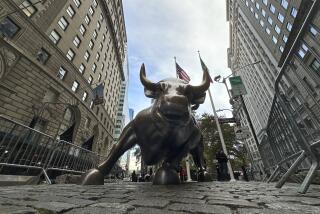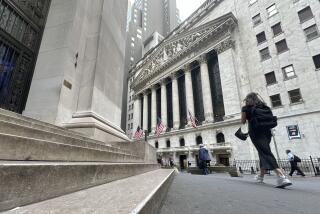We Never Learn Our Lessons, But So What?
With the stock market on the way to its worst calendar-year performance since the late 1970s, it’s pretty clear what many investors would ask if only one holiday wish could be granted:
“Well, yes, peace on Earth would be nice, but more personally helpful would be if I could go back to March for a moment and stop myself from paying $150 a share for that Internet stock that’s now worth $2.44.”
If a lack of divine intervention forces you to go on living with your mistakes, you’re at least supposed to learn from them. So this is the part where the columnist is supposed to ask you to pledge never to (fill in the blank) again with your money. Nah.
With the crash in technology stocks this year, it’s understandable that the search for the perpetrators has begun. Who did this to us? Who let it get so out of hand? Where were the regulators? Where was the Supreme Court?
But the question of who, or what, to blame is probably best answered by a geneticist. We do what we do, as investors and in every other aspect of our lives, because we’re governed by basic emotions that haven’t changed much in eons.
Our kids want scooters this holiday because scooters are fun, and they’re “hot.” Will we eventually get carried away again by some investment trend that’s fun and/or hot? You bet.
Will we again push prices of some securities far too high and others far too low? Inevitably. In fact, we’re doing it right now.
*
Because market tops and bottoms are easily discerned in retrospect, we forever wonder why we didn’t recognize them at the time--or, more to the point, why we didn’t take action at the time.
But that is exactly what makes markets: It stands to reason that the majority of participants can’t buy at the bottom or sell at the top. The majority must be fooled, or must be kept sidelined by indecision or inertia.
The concept of market indexing--just buying and holding a mutual fund that replicates the performance of the Standard & Poor’s 500 index--is an acknowledgment of all of the above.
It says you can’t beat the market, because the market knows your human weaknesses, your propensity to act irrationally. So if you can’t beat it, you join it.
Granted, losing 13% or so in an S&P; 500 fund this year feels a lot less painful than losing 40% in a technology-stock fund.
But indexing offers no challenge. Creating your own mix of investments, and buying and selling at the perfect times--that’s a challenge. Even if we don’t beat the index in the long run, we tried because we were able to try.
You’ll get no argument against indexing here. It makes perfect sense, and it’s easy. But riddle me this: Out of $3.1 trillion or so in U.S. stock mutual fund assets, why is less than 10% of that sum in S&P; 500 index funds and the rest in funds trying to beat the S&P;?
(OK, this is one answer: Stock mutual funds are sold to people by fund companies and brokers who have a vested interest in touting active portfolio management. Even so, people buy into the idea because it’s in their nature to do so. It is not in their nature to settle for the guaranteed mediocrity of indexing, regardless of how much sense it may actually make.)
If you aren’t going to index, however, it could indeed serve you well to learn from your investing mistakes--or better, from the mistakes of others.
For example, elementary portfolio diversification--making sure you don’t have too many dollars in one type of investment--is still the best way to guard against the risk of irreparable financial harm. Period.
*
The person who has lost 40% on a tech-stock fund that comprised one-fifth of his investment portfolio may be unhappy this holiday season, but the person who has lost 40% on a tech fund that comprised his entire portfolio is most likely inconsolable.
Here’s another idea: If you think you absolutely must own an investment but it seems to be richly valued, go slow. Instead of committing, say, $1,000 to the investment now, commit $250 and mark your calendar to buy another $250 in a month or two. This way, you’re in the game, but you aren’t controlled by the game.
If you invest via a 401(k) plan or other automatic investment program, you’re already following this route, of course.
What about the “rules” we now hear recited over and over--about never buying shares of untested companies (the “dot-coms”), about avoiding high-price-to-earnings stocks altogether (Cisco Systems, etc.), about turning away from whatever the crowd is clamoring for on Wall Street?
Those rules may well protect you from heavy losses. But they also may ensure that you’ll never experience the thrill of hitching a ride on a big winner.
The accompanying chart shows what happened to selected stocks in two booms: the tech-stock craze of the late 1960s and the Internet-stock craze of 1999 and early this year.
In both periods, people paid astronomical prices for stocks based on a combination of legitimate hopes, absurd hype and pure greed. Both times, the end result was a collapse of prices, on the order of 80% or more.
But along the way, decent money was made by people who bought and sold early, or at least not too late.
Stock manias don’t need defending. They’re simply the extremes of the market’s natural cycles. To lecture investors against “doing that again” is rather silly. They will, because they’re human.
When we get over this current market slump, the fastest-growing companies will still command above-average price-to-earnings ratios. The seeds of a new mania will have been sown, perhaps in business ideas we haven’t yet fathomed.
A wise money manager once said, “There is no such thing as a growth stock--just companies in growth phases.”
Those companies are almost always what investors want to own. The issue may be over the price paid at a given moment, but the basic appeal is hardly mysterious--or wrong.
*
Tom Petruno can be reached at tom.petruno@latimes.com. For recent columns on the Web, go to https://www.latimes.com/petruno.
(BEGIN TEXT OF INFOBOX / INFOGRAPHIC)
History Repeats on Wall Street
The tremendous run-up in technology stocks early this year
and the crash that followed have parallels in the rise and destruction of late-1960s technology stocks during the infamous “go-go” era for growth stocks. Shown here is a sampling of stocks from both eras and how they tumbled, along with the stocks’ peak price-to-earnings (P/E) ratios.
The 1960s ‘Go-Go’ Era
*--*
1968 1970 Pctg. P/E Stock high low drop at high Fairchild Camera $102.00 $18.00 -82% 443 Teledyne 72.00 13.00 -82 42 Control Data 163.00 28.00 -83 54 Mohawk Data 111.00 18.00 -84 285 Electronic Data 162.00 24.00 -85 352 Optical Scanning 146.00 16.00 -89 200 Itek 172.00 17.00 -90 71 University Computing 186.00 13.00 -93 118
*--*
The Internet Era
*--*
52-week Friday’s Pctg. P/E high close drop at high Redback Networks $198.50 $49.75 -75% 3,970 EBay 127.50 35.00 -76 607 Sycamore Networks 199.50 35.00 -82 867 Amazon.com 102.00 15.56 -85 NA Yahoo 250.06 29.56 -88 521 Conexant Systems 132.50 15.13 -89 158 Inktomi 241.50 24.94 -90 2,195 Priceline.com 104.25 1.28 -99 NA
*--*
NA: Not applicable (net loss expected this year)
Sources: Dun’s magazine, Bloomberg News, IBES International
More to Read
Inside the business of entertainment
The Wide Shot brings you news, analysis and insights on everything from streaming wars to production — and what it all means for the future.
You may occasionally receive promotional content from the Los Angeles Times.










